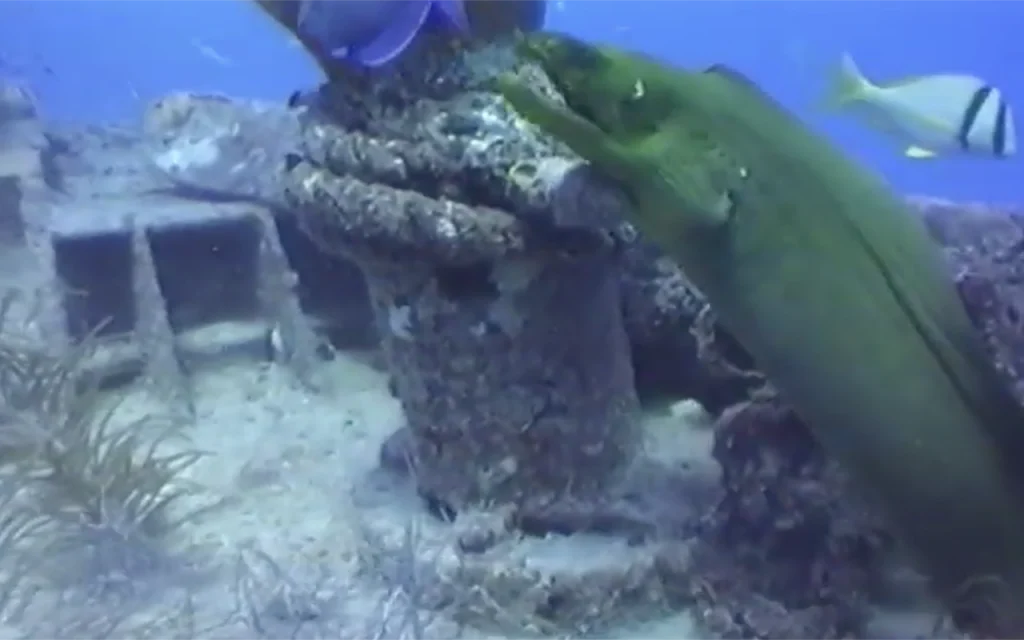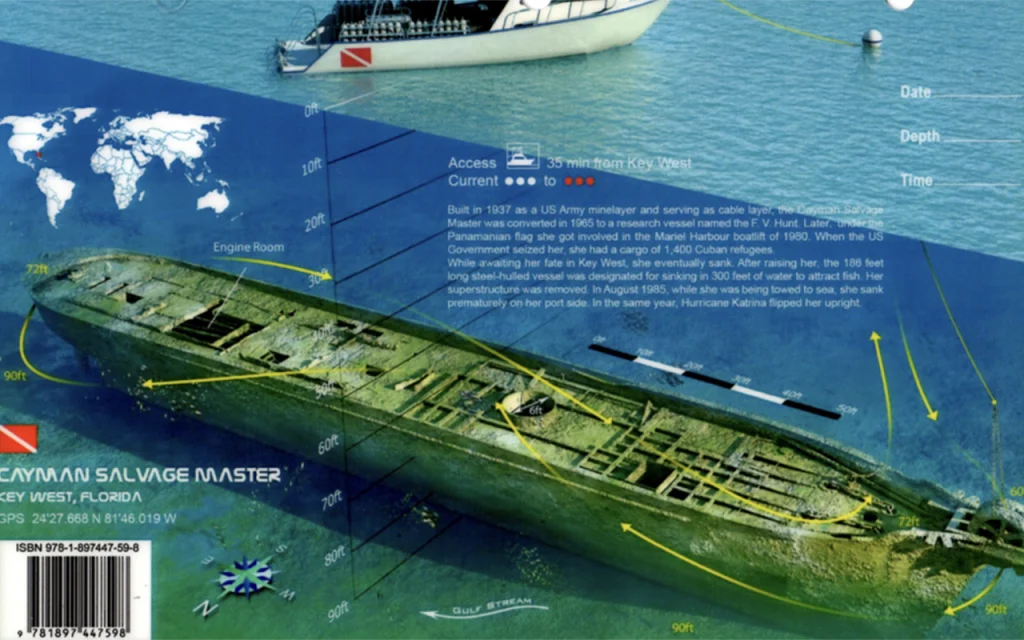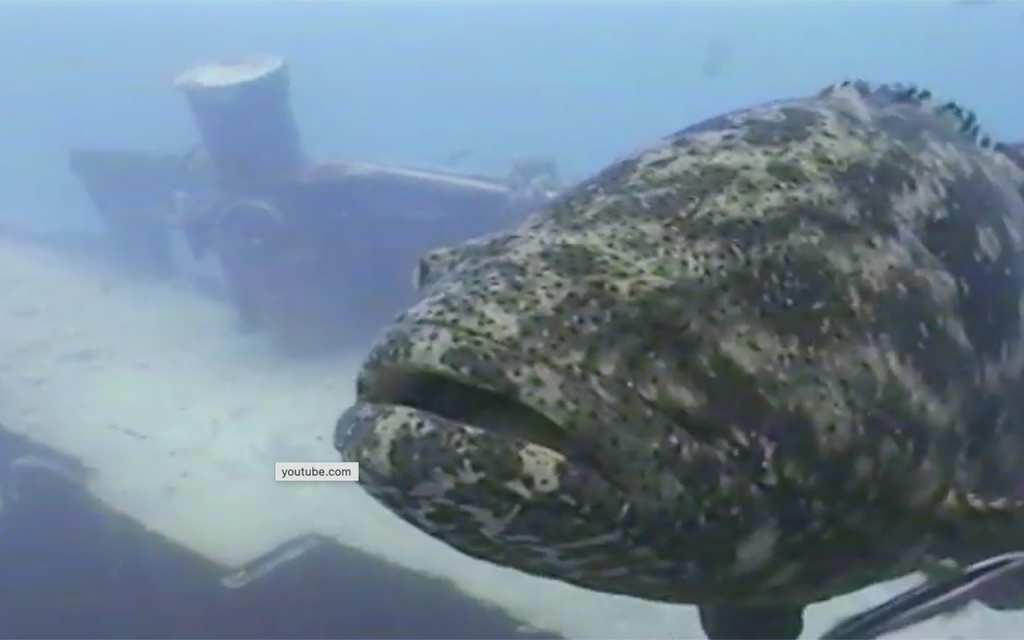Table of Contents

Overall, the Cayman Salvage Master is regarded as a memorable dive site, combining historical intrigue with a rich marine environment, though it is best suited for those with some diving experience.
Article at a Glance
- Historical Significance: The Cayman Salvage Master, originally a U.S. military vessel, has a rich history, including its role during the Mariel boatlift in 1980.
- Unique Features: Divers can explore artifacts such as bicycles left by Cuban refugees, a public payphone, and a large cable spool, all contributing to the wreck’s character.
- Diverse Marine Life: The wreck is home to a variety of marine species, including goliath groupers, moray eels, nurse sharks, and vibrant coral growth, making it a lively dive site.
- Safety Measures: Recommended for advanced divers, safety precautions include diving with a guide, carrying essential safety equipment, and planning dives carefully to account for currents.
- Dive Depth: The wreck lies at a depth of approximately 90 feet (27 meters), making it suitable for experienced divers comfortable with deeper dives.
- Popular Dive Shops: Several dive shops offer trips to the Cayman Salvage Master, including:
- Eden Rock Diving Center
- Don Foster’s Dive Cayman
- Ocean Frontiers
- Divetech Grand Cayman
- Living The Dream Divers
- Atlantis Dive Center
- Wall to Wall Diving
- Memorable Experience: The combination of historical intrigue, unique artifacts, and rich marine biodiversity makes diving the Cayman Salvage Master a memorable and rewarding experience for divers.
Cayman Salvage Master Wreck Location Coordinates and Depth
Depth
The wreck sits at a maximum depth of approximately 93 feet (28 meters) on a sand bottom, with varying depths across different parts of the wreck, such as 60 feet at the bow and 72 feet on the deck.
Location Coordinates
The Cayman Salvage Master wreck is located at the following coordinates:
- Latitude: 24° 27.210′ N
- Longitude: 81° 45.980′ W

What to Scuba Divers Say About This Wreck
- Good Intermediate Dive: Many divers describe the wreck as a solid choice for intermediate divers. The wreck is mostly intact, offering a safe environment for exploration, although penetration is limited due to safety concerns.
- Marine Life: The wreck is home to a diverse array of marine life, including large goliath groupers, moray eels, and various tropical fish. Divers often note the vibrant underwater ecosystem that has developed around the wreck, making it an exciting dive site.
- Unique Features: Divers have reported interesting artifacts on the wreck, such as bicycles left by Cuban refugees, a public payphone, and a large cable spool. These features add to the wreck’s charm and provide points of interest for exploration.
- Visibility and Conditions: The visibility at the site is generally excellent, but divers should be aware of strong currents due to its proximity to the Gulf Stream. This makes the dive more suitable for experienced divers who can handle unpredictable conditions.
- Safety Precautions: Due to potential entanglement risks, it is recommended that divers carry a knife and a flashlight. Familiarity with the wreck’s layout is also advised, especially for those diving for the first time.
What Kind of Marine Life Can Be Found on The Wreck
- Goliath Grouper: These large fish are often seen around the wreck, adding to the site’s allure.
- Moray Eels: Green moray eels are frequently spotted swimming through the wreck’s openings, providing an exciting sight for divers.
- Nurse Sharks: These gentle sharks can also be found resting near the wreck.
- Tropical Fish: A variety of tropical fish inhabit the area, including bar jacks, barracudas, and silversides.
- Octopus: Divers may encounter octopuses hiding in crevices around the wreck.
- Loggerhead Sea Turtles: These turtles occasionally visit the site, contributing to the rich biodiversity.
- Coral Growth: The wreck has developed a coral ecosystem, which attracts various marine species and enhances the underwater scenery.
Key Information
| Aspect | Details |
|---|---|
| Location | Key West, Florida |
| Coordinates | 24° 27.210′ N, 81° 45.980′ W |
| Depth | 90-95 feet (27-29 meters) |
| Visibility | 50-100 feet (15-30 meters) |
| Current | Can be strong due to proximity to Gulf Stream |
| Skill Level | Intermediate to Advanced |
| Original Purpose | U.S. Army mine layer and cable ship |
| Year Built | 1936 |
| Length | 187 feet (57 meters) |
| Sinking Date | 1985 |
| Notable Features | Bicycles, payphone, cable spool |
| Marine Life | Goliath groupers, nurse sharks, moray eels, tropical fish |
| Best Time to Dive | Year-round, but summer offers calmest conditions |
| Penetration | Limited due to safety concerns |
| Recommended Equipment | Dive knife, flashlight |
What Makes Cayman Salvage Master a Unique Diving Experience
- Historical Significance: The wreck has a fascinating and checkered history, having served various roles from a mine layer to a buoy tender for the U.S. Coast Guard. Its involvement in the Mariel boatlift, where it was seized with 1,400 Cuban refugees aboard, adds to its intrigue.
- Intact Structure: The wreck is mostly intact, providing a safe environment for divers to explore. It was transformed into an artificial reef, which enhances its structural integrity and creates a habitat for marine life.
- Unique Artifacts: Divers can discover unusual features on the wreck, such as bicycles left by Cuban refugees, a public payphone, and a large cable spool. These artifacts contribute to the wreck’s character and provide interesting points of exploration.
- Rich Marine Life: The site is home to diverse marine species, including large goliath groupers, moray eels, and various tropical fish. The developing coral growth around the wreck adds to the vibrant underwater ecosystem, making it a visually stunning dive.
- Challenging Conditions: While the wreck is accessible, it is recommended for advanced divers due to strong currents and potential entanglement risks. This adds an element of challenge and excitement for experienced divers.
- Diverse Dive Depths: The wreck lies at a depth of approximately 70 to 95 feet, making it suitable for divers who are comfortable at deeper depths while still being accessible for exploration.
What is The Full History of This Wreck
Early History and Construction
- Built in 1936: The Cayman Salvage Master was originally constructed as a mine layer for the U.S. Army, designed for both laying mines and running communication cables. It was notable for being the first diesel-electric vessel with these capabilities.
- Service in the U.S. Coast Guard: After its military service, the vessel was repurposed as a buoy tender, assisting in navigation and safety operations along the U.S. coastline.
Later Years and Mariel Boatlift
- Seizure During the Mariel Boatlift: In 1980, during the Mariel boatlift—a mass exodus of Cubans fleeing to the United States—the Cayman Salvage Master was seized by U.S. authorities while illegally transporting 1,400 Cuban refugees. Following its seizure, the ship was towed to Key West.
- Sinking at Dock: Shortly after being towed to Key West, the vessel sank unexpectedly while docked, marking the beginning of its transformation into an artificial reef.
Artificial Reef Transformation
- Refloating and Preparation: In 1985, plans were made to refloat the wreck and prepare it for sinking as an artificial reef. The superstructure was removed, and the ship was cleaned to eliminate hazards for marine life.
- Accidental Sinking: While being towed to its intended sinking site in deeper waters, a cable snapped, causing the Cayman Salvage Master to sink in approximately 90 feet of water instead of the planned 300 feet. Initially, it settled on its port side but was later righted by the forces of Hurricane Kate.
Current Status
- Diving Destination: Today, the wreck sits upright on a sand bottom at a depth of about 92 feet and has become a popular dive site known for its rich marine life and unique features, such as bicycles left by refugees, a public payphone, and a large cable spool.
- Marine Ecosystem: The wreck has developed into an artificial reef, attracting various marine species, including goliath groupers, moray eels, and loggerhead sea turtles, making it a vibrant spot for divers.

What Historical Features Can Still Be Identified on Wreck
- Bicycles: There are three bicycles on board, believed to have been left by Cuban refugees during the Mariel boatlift. These bikes have become iconic elements of the wreck.
- Public Payphone: A unique artifact, the payphone adds a historical touch to the wreck and serves as a point of interest for divers exploring the site.
- Cable Spool and Pulley: Located at the bow of the wreck, these items are remnants of the vessel’s past as a mine layer and buoy tender, showcasing its operational history.
- Rudder: The rudder can be found under the stern of the wreck, highlighting its former functionality as a vessel.
- Coral Growth: Over the years, the wreck has developed a thriving coral ecosystem, which not only enhances the underwater scenery but also attracts diverse marine life, adding to the wreck’s historical and ecological significance.
What Safety Measures Are in Place for Divers Visiting Cayman Salvage Master
- Experience Level: The site is recommended for advanced divers due to its depth (approximately 90 feet) and the potential for strong and unpredictable currents. It is advisable for divers to have prior experience with wreck diving and to be familiar with the conditions of the area.
- Guided Dives: Divers are encouraged to dive with someone experienced in navigating the wreck. This is particularly important for those visiting for the first time, as familiarity with the wreck’s layout can enhance safety and enjoyment.
- Safety Equipment: Divers should carry essential safety gear, including a scuba diving knife to cut away any potential entanglements and a flashlight for visibility in darker areas of the wreck. These tools are crucial for navigating the wreck safely and addressing any unexpected situations.
- Dive Maps: Utilizing a dive map specific to the Cayman Salvage Master is recommended. These maps provide crucial information about the wreck’s layout and help divers orient themselves during the dive.
- Dive Planning: Proper dive planning, including checking current conditions and weather forecasts, is essential. Divers should be aware that strong currents can affect their dive experience, making it necessary to plan accordingly.
Dive Shops That Prove Diving Trips to This Shipwreck
- Eden Rock Diving Center Ltd
- Rating: 4.7
- Address: 124 S Church St, George Town KY1-1110, Cayman Islands
- Website: Eden Rock Diving Center
- Don Foster’s Dive Cayman
- Rating: 4.8
- Address: 218 S Church St, George Town KY1-1206, Cayman Islands
- Website: Don Foster’s Dive Cayman
- Ocean Frontiers Dive Shop
- Rating: 4.9
- Address: 344C Austin Conolly Drive, Grand Cayman KY1, 1801, Cayman Islands
- Website: Ocean Frontiers





